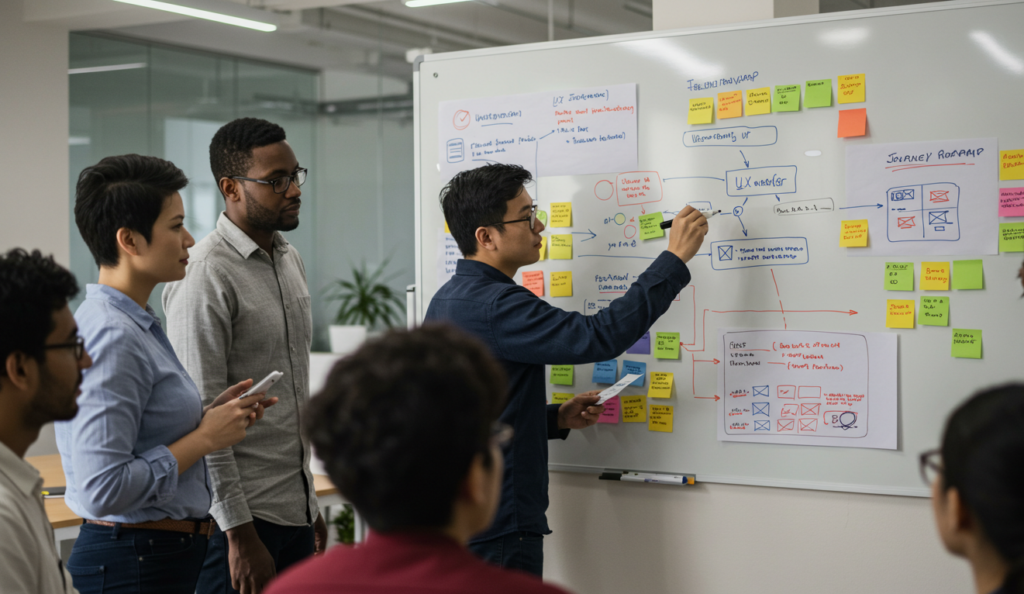
Everyone wants transformation. Few want the trade-offs. But here’s the truth: design constraints aren’t your enemy—they’re the supportive catalyst for new innovation.
Constraints are the reality in every large organization. You’re working with legacy systems, tangled stakeholder maps, and a backlog of ideas that never saw daylight. That’s not a barrier. That’s the brief.
Real-world innovation doesn’t start with a blank slate—it starts with a box.
Why design constraints are innovation’s secret weapon
Dreaming big is easy when time and money are limitless. But no one is giving you that runway. And that’s why small, focused shifts can have the biggest outsized impact.
Design constraints help us to sharpen focus. They create the right amount of due urgency. They force our teams to make better decisions. When a team aligns on what’s seemingly immovable, it becomes easier to spot what is possible.
Look at how others are working inside the box:
- Duolingo embraced cognitive and attention-span constraints to gamify learning, using short lessons and AI-driven chat to keep users engaged and progressing—without expanding complexity
- Spotify’s squad model enabled fast iteration across a sprawling enterprise by leaning into autonomy, not fighting for top-down control. It thrived under organizational complexity.
- Companies like Microsoft and Uber are actively leveraging design systems to reduce design debt and speed up work in complex orgs where sharing components and maintaining standardization greatly impacts efficiency and the overall user experience.
- IKEA designs under supply chain and sustainability constraints—using fewer materials, flat-pack logic, and emissions limits to drive simpler, more scalable product decisions.
These companies didn’t wait for ideal conditions or blank slates. They accepted their constraints and used them to drive focus, speed, and clarity.
Think constraints are blockers? Flip them into structure
Design limitations aren’t roadblocks. Rather, they’re scaffolding. When applied strategically, they provide the shape for faster, more confident decisions.
Here’s how to reframe them in your day-to-day work—whether you’re facing design trade-offs, tight timelines, or creative roadblocks:
- Time constraints = test early, not perfectly:
Use timeboxing to surface direction—not perfection. For instance, when we need to conduct research inside a very limited timeframe, we craft small experiments to validate hypotheses and inform direction. It may not be statistically significant, but it’s often enough to de-risk a decision. And if that level of confidence isn’t enough? That’s a signal your process needs more time, not less. - Legacy tech = build bridges, not replacements:
Use APIs or wrappers to test around existing systems before diving into a full refactor. One common example is mobile design—specifically, deciding what should leverage native capabilities versus web views. There are elegant ways to load web content inside a mobile app without disrupting the user experience. Working within these constraints often leads to sharper prioritization and smarter hybrid solutions.

When design constraints get tougher, we get smarter
- Budget constraints = focus on signals over polish:
Build lean prototypes that validate big assumptions and iterate constantly. In our experience, sometimes we make quick decisions to skip wireframing for instance and go directly to high-fidelity mockups. Sometimes we opt to stay within wireframing and test wireframe prototypes with users. There are a number of ways to still remain flexible inside a constrained budget. One of our recent projects saw Grand Studio partner up with a food and retail brand to experiment with a new, AI-powered franchise performance tool. Even with budget limitations, our solution explored a variety of opportunities for improved store-level decision-making without requiring a full systems overhaul. - Regulatory or policy constraints = narrow the playing field:
Fewer options means more clarity. Use it to your advantage. Competitors are likely struck with similar design constraints as well. Therefore, your team needs to be more creative in how you design to them. We’ve worked inside highly regulated spaces before. Instead of treating these as blockers, we translate regulations into clear design boundaries—unlocking higher confidence among stakeholders. For example, Grand Studio recently helped a life insurance company reimagine its direct-to-consumer model—creating new process efficiencies along the way while staying fully compliant.
Instead of waiting for perfect alignment, find small bets you can run within existing design constraints. Especially when outcomes tie directly to business pain, design trade-offs give you focus.
Don’t fight politics. Use them to your advantage.
Political constraints are often the hardest to navigate. “We’ve always done it this way” isn’t just inertia—it’s protection. Still, we need to reframe change so it doesn’t feel like overwhelming risk—then we can open doors to move forward.
Try anchoring new ideas in established goals. Show how a proposed workflow supports what leadership already values. Then, instead of pitching a bold vision, build a low-fi prototype they can respond to. Prove how we can layer in change over time to shift the organization incrementally.
Next, bring in cross-functional allies early. Pre-pitch alignment reduces resistance later. At Grand Studio we look to do this all the time in client projects—identify key stakeholders with influence and find ways to engage them throughout the process. Buy-in should be a shared, collaborative process. Finally, highlight even the smallest success—proof that change can happen without asking to move mountains.

Reinvent the space when you can’t make more time
Perhaps you can’t access customers directly. Maybe your roadmap is locked down by engineering timelines. Even so, you can still learn and make progress inside tight design constraints.
Use the data you already have: CRM notes, sales calls, and support logs. Alternatively, sketch user journeys with front-line teams who see pain points daily. Even short co-design sessions can generate fast alignment.
Also, try mapping your dependencies in a visual way. A quick whiteboard session often delivers surprising clarity. We do this all the time with user journeys and service blueprints to unlock moments of opportunity for where users meet technology. Why can’t the same process work for internal design constraints? Simply put: constraints in access or time don’t erase the search for insight—they simply can change how you find it.
Start small. Go faster. Deliver better.
You don’t need a mandate for total transformation. What you need is room to test one new idea inside your very real set of constraints.
Find the edges. Define a minimal shift. Build just enough to learn. Prove there’s value inside the box.
That’s how transformation happens—in short, meaningful bursts. Not by waiting for freedom. But by designing with the limits you’ve got.
At Grand Studio, we don’t work around constraints—we work with them. Our design methodologies are built to clarify complexity, embrace design constraints, and deliver measurable business outcomes—on time and on budget. If you’re navigating design limitations, we’ll help you turn them into leverage. Get in touch and let’s make your next project the one that proves what’s possible.


